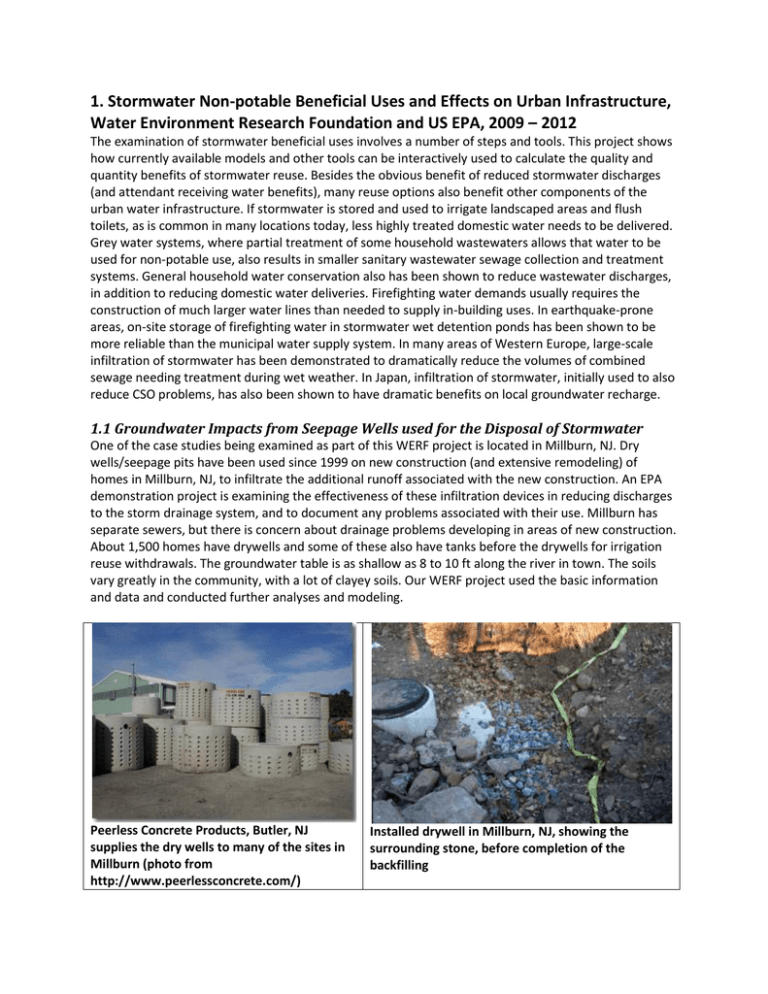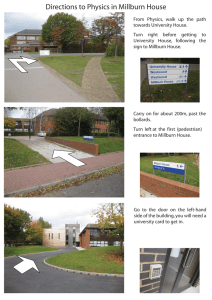1. Stormwater Non-potable Beneficial Uses and Effects on Urban Infrastructure,
advertisement

1. Stormwater Non-potable Beneficial Uses and Effects on Urban Infrastructure, Water Environment Research Foundation and US EPA, 2009 – 2012 The examination of stormwater beneficial uses involves a number of steps and tools. This project shows how currently available models and other tools can be interactively used to calculate the quality and quantity benefits of stormwater reuse. Besides the obvious benefit of reduced stormwater discharges (and attendant receiving water benefits), many reuse options also benefit other components of the urban water infrastructure. If stormwater is stored and used to irrigate landscaped areas and flush toilets, as is common in many locations today, less highly treated domestic water needs to be delivered. Grey water systems, where partial treatment of some household wastewaters allows that water to be used for non-potable use, also results in smaller sanitary wastewater sewage collection and treatment systems. General household water conservation also has been shown to reduce wastewater discharges, in addition to reducing domestic water deliveries. Firefighting water demands usually requires the construction of much larger water lines than needed to supply in-building uses. In earthquake-prone areas, on-site storage of firefighting water in stormwater wet detention ponds has been shown to be more reliable than the municipal water supply system. In many areas of Western Europe, large-scale infiltration of stormwater has been demonstrated to dramatically reduce the volumes of combined sewage needing treatment during wet weather. In Japan, infiltration of stormwater, initially used to also reduce CSO problems, has also been shown to have dramatic benefits on local groundwater recharge. 1.1 Groundwater Impacts from Seepage Wells used for the Disposal of Stormwater One of the case studies being examined as part of this WERF project is located in Millburn, NJ. Dry wells/seepage pits have been used since 1999 on new construction (and extensive remodeling) of homes in Millburn, NJ, to infiltrate the additional runoff associated with the new construction. An EPA demonstration project is examining the effectiveness of these infiltration devices in reducing discharges to the storm drainage system, and to document any problems associated with their use. Millburn has separate sewers, but there is concern about drainage problems developing in areas of new construction. About 1,500 homes have drywells and some of these also have tanks before the drywells for irrigation reuse withdrawals. The groundwater table is as shallow as 8 to 10 ft along the river in town. The soils vary greatly in the community, with a lot of clayey soils. Our WERF project used the basic information and data and conducted further analyses and modeling. Peerless Concrete Products, Butler, NJ supplies the dry wells to many of the sites in Millburn (photo from http://www.peerlessconcrete.com/) Installed drywell in Millburn, NJ, showing the surrounding stone, before completion of the backfilling Underground water storage cistern in Millburn, NJ Pump for irrigation system Modeling showed that the cisterns provide an overall runoff reduction of about 24% for each home. Because of the relatively poor soils in the area and the large amounts of landscaping for the large lots, most of the runoff originates from the small landscaped areas that are not treated by these controls. The natural runoff from this area is also relatively high due to the soils. When compacted during the construction activities and general land use activities, soils with some clay become quite impermeable. These drywells provide much of their infiltration benefits at lower depths that are not subjected to the compacted. 160 10/02/2009 10/12/2009 140 120 Depth (cm) 100 80 07/31/2009 08/02/2009 60 08/02/2009 08/06/2009 07/29/2009 40 07/31/2009 20 0 -20 0 500 1000 Time (hr) Monitored water levels in dry well in Millburn, NJ. 1500 2000








